Meredith Arthur's Blog, page 2
July 21, 2024
The Ultimate Stress Relief Cheat Sheet

If you can stop your nervous system from trying protect you, you can lessen your pain and quell your anxiety.
Hello reader! I’m Meredith Arthur. I work as a Chief of Staff for Pinterest’s product incubation studio and am the founder of Beautiful Voyager, a content and community site for overthinkers, people pleasers, and perfectionists.
I first started my journey into mental health research in 2015 when the neurologist treating my migraines diagnosed me with Generalized Anxiety Disorder. At the time, I found the Google results for “what is an anxiety disorder?” sorely lacking and I created Beautiful Voyager to fill the gap. My curiosity only deepened as I asked the same question over and over: Why didn’t I ever know that anxiety was contributing to the terrible physical symptoms (migraines, nausea, fainting, back pain, cramping) I was experiencing?
In 2016 I expanded my research by taking over the editor-in-chief role for Medium’s largest mental health publication, editing hundreds of personal mental health essays from people around the world. In 2020, just three months into the COVID pandemic, I published my first book on anxiety. That same year, I started working on the nonprofit How We Feel app with Ben Silbermann and Dr Marc Brackett. Since then, thanks to my partnership with the Pinterest social impact team, I’ve gotten to know the founders of many mental health nonprofits and stayed close to new trends in the space. It’s an ongoing journey that I find fascinating both on a personal level and a societal one.
Why a stress relief cheat sheet?
My understanding of anxiety has changed radically over the past nine years of curious investigation. I’ve explored many schools of thought and approaches to anxiety treatment. Take a look at how my answers to the questions “Why didn’t I know that I was suffering from anxiety?” and “Is anxiety connected to the terrible physical symptoms I’m experiencing?” have evolved over time:
2015: I don’t care why I didn’t know. I want to know why the therapists I saw didn’t know.
2017: Seems like, in the field of mental health, you need to know what’s wrong with you for people to be able to help you. At least I have Lexapro now.
2019: I guess I hid it so well that I unintentionally hid it from myself? I still have physical symptoms. I continue to be grateful for Lexapro, which helps me turn down the thermostat on my internal environment, especially on anxious mornings.
2021: I am still really sick—nausea, muscle aches, migraines, lightheadedness. Is anxiety connected to the physical pain I am in? I still don’t get it. COVID hasn’t helped.
2023: After a year spent in bed, something finally helped: I had a hysterectomy. I’m grateful to see a decrease in my physical symptoms, but I am still in pain. I don’t know what to do next. I suspect my nervous system plays a role here.
2024: I finally get it —I have spent a lifetime in a state of nervous system dysregulation. I believe I can improve my physical and mental health by regulating my nervous system. My pain is diminishing. It’s a daily practice, but I am healing.
I’m writing this cheat sheet to help you skip some of the steps I labored through over the years. Everything I share here is an honest recounting of what’s working for me based on personal experience.

Who you are
If you’re reading this, I’m assuming you’re a fellow voyager, a curious overthinker learning to navigate the choppy waters of stress and anxiety from other wayfaring overthinkers.
The philosophy behind this cheat sheet
If you can stop your nervous system from clumsily trying protect you, you can lessen your pain and quell your anxiety. Teaching yourself that you are safe is where this work begins. It’s as hard as it sounds. Your nervous system’s off switch is buried within a sea of internal confusion. (I’m simplifying the nervous system here — there’s no simple on and off switch. Your nervous system is more like fancy LED lights. The switch allows you to change the color and flashing patterns of the lights so that you can give yourself the right lights at the right time. No one needs fluorescent disco lights at 9 AM on a Monday morning. )
To become skillful at using the switch, you must find a path through the internal cacophony and learn which part of yourself to listen to when. A great place to start is with actionable nervous system regulation tactics.
Let’s get started.
Every technique I’m including has the same goal: to teach your body that you are safe. The best approach to all nervous system regulation is “little and often.” In other words, these are exercises that you can do in the moment to send messages of safety to your body (which, in turn, will send them to your mind and help you feel better overall).
Start with foundational, everyday practices.
If you start reading about nervous system regulation, it won’t be long until you start hearing about the “window of tolerance.” Your window of tolerance is, quite simply, your ability to tolerate the challenges of daily life. It’s your body’s ability to move from a hyper-aroused (fight or flight) or hypo-aroused (withdrawn, frozen) back to a more grounded self and place. If you’re interested in learning more about these three states, a great place to start is Stanley Rosenburg’s book on polyvagal theory. These daily practices build your window of tolerance so that you can recover more quickly and easily from nervous system arousal. (The nervous system exists to protect us. It is doing its job by going into an aroused state. The goal is to build a window of tolerance that lets you handle these inevitable daily stressors gracefully and intentionally, without your system being hijacked without you knowing it.)
1. Somatics
I’ve come to think of my daily somatic practice as meditation with movement. Every morning I unroll my yoga mat and follow one of Sarah Warren’s online classes, usually first thing in the morning, in order to release muscle tension and teach my body what relaxed is supposed to feel like. I recommend starting with her level one course. It is a guided experience that builds upon itself every day, costs $45, and take two months to complete. It takes around 20-30 minutes a day.
2. Polyvagal exercises
I bundle the following three lateral eye-movement exercises with my morning practice. They are adapted from Accessing the Healing Power of the Vagus Nerve by Stanley Rosenberg. Critics will tell you that we don’t yet understand the mechanism that makes this kind of exercise work, warning you to sidestep the hype. While I support a healthy dose of skepticism in all wellness endeavors, it doesn’t hurt you to give them a try as they are easy and totally free. I’ve definitely found them helpful for releasing my trapezius muscle and easing my morning anxiety.
The Basic Exercise
Sit tall wherever you are.
Interlace your hands and clasp the back of your head between your ears, sending your amygdala a message of safety.
With your EYES ONLY, look to the right and hold.
Breathe, relax, and allow your body to soften.
Hold 30-60 seconds until you yawn or feel an internal shift. It can take practice to learn to feel this shift, but the yawn is a dead giveaway that this is working.
Repeat on the left side.
Seated Salamander Exercise
I like to do this exercise on my heads and knees so that gravity helps me breath out with my belly. You can also do it sitting up. Whatever works for you to get the release.
With your EYES ONLY, look to the right and hold.
Allow your right ear to melt towards the right shoulder (not turning your head).
Breathe, relax, allow your head to be heavy and you body to soften.
Hold 30-60 seconds until you yawn or feel an internal shift. It can take practice to learn to feel this shift, but the yawn is a dead giveaway that this is working.
Repeat on the left side.
Sphinx with Head Turn
Lay on your belly and prop yourself up on your elbows with your chest and head facing forward.
Anchor your pelvis by pressing down through the pubic bone.
Draw your shoulders down out of your ears and extend your neck naturally (don’t look up too much).
Turn your head to look over your right shoulder and hold for 1 minute. Again, ou are looking for that yawn or internal shift into ease.
Repeat exercise looking over left shoulder.
3. Brecka breath
I do this practice every morning as part of my somatics/polyvagal routine. It was recommended by a somatic teacher who said, “It may look and feel a bit bro-y, but if you are oxygen-deprived due to stomach gripping or tension myositis syndrome, this kind of breathing can help you.”
What separates this practice from others, as far as I can tell, is the intentional pause you take between rounds of breath. In this special pause you relax and tune into the sounds of the world around you. Stay in that space for a few beats before slowly inhaling, exhaling, then returning to the next round. It took me a while to catch the hang of it, but now I really love that pause.
How to Brecka breathe
When just getting started, do 3 rounds of 10 breaths.
Inhale deeply as shown in the video. Exhale naturally. Do this breath 10 times in a row.
Let your shoulders rise as you breathe in. Fill your chest and belly on the inhale. Allow the exhale to follow the inhale without overthinking it.
Once you have finishes one round of 10 breaths, pause on the inhale. Do not exhale.
Tune into the sounds around you and try not to tense up as you hold the breath. Relax into the feeling. Check out the video to see what this looks like.
Once you’ve held that inhale as long as you can, slowly inhale and exhale, then get ready for round two.
Do another round of 10 breaths, same as above, then pause again on the inhale.
Repeat one last time.
Over time, build to 3 rounds of 30 breaths.
4. Mindset/emotion check-in
Every day I set aside at least 10 minutes to “tidy” my mindset. Depending on the day, I do this by journaling or sitting quietly in the sun. The goal is the same — to create the internal space to understand what’s happening that day on a deeper emotional level.
I use Nicole Sachs’ approach to journaling. It’s called Journal Speak. When you sit down to Journal Speak, your goal is to speak directly from the emotion itself, unmediated by thought or analysis. This is radically different from the way I journaled throughout my 20s, which was filled with overthinking and self-analysis. Remember, many of us unintentionally suppress and avoid emotions we perceive as negative. When we give voice to unconscious negative emotions, we’re defanging them and soothing our nervous systems.
When I’m not in the right place to journal, I do this same practice without paper, sitting quietly in the sun to tune into the negative chatter in my head. I try to feel the emotions surfacing in my body. I allow myself to rest in uncomfortable emotional spaces. This is not easy but I know that it’s important: By teaching myself emotions aren’t as scary as they seem, I am regaining control of my nervous system’s master switch. Once I’ve done that enough, I send soothing mantras/phrases to the parts of my internal self that are complaining the loudest.
5. Afternoon gear shift
Nervous system regulation is best practiced in small and frequent ways. It’s important to learn to shift gears periodically throughout the work day — moving from the sympathetic part of the system (“flight or fight”) to the ventral (“safety and connection”).
Learning to relax in between tasks is another way of mastering your nervous system’s light switch.5 I do this by taking a quick moment in the middle of the day to connect with nature. This could be 5 minutes spent in my backyard, a small walk up and down the street examining tree leaves, or sitting and petting my dogs. I tell myself, “It’s OK to coast sometimes. I don’t always need to be in overdrive.”
I’m a broken record but will say one more time: the goal is to teach yourself that you are safe. If you are able to do that, your entire system can relax, your pain will be lessened, and your anxiety will plummet.

Exercises for difficult moments
Everyday practices are great, but what should you do when you’re facing something hard? Ground, Orient, Resource.
Ground yourself by becoming aware of your feet on the ground or the seat under you. Orient yourself by selecting five things in your immediate environment to focus on, spotting details like color, form, and texture. Resource yourself by finding a small action that tells your nervous system you are safe. If any of these exercises resonate with you, they can act as your resources when you need them.
1. In-the-moment mantra
Too often overthinkers want to fix everything at once, and while that is a nice idea, it’s not always realistic. Having a phrase or mantra you say to yourself is a way to shift your mindset in the moment when you need it.
What makes a good mantra
It has to be a phrase you truly believe — your nervous system will know if you’re faking it
It should be powerful enough to interrupt unproductive or negative thinking
It should be connected to a topic that tends to cause you stress
Examples of mantras I currently use
“I am allowed to have a vacation from [insert issue].”“I know that future me has [insert issue] covered, so I am going to let this go for now.”
“If I keep thinking this way, I will only get sicker. Instead, I am going to imagine a future in which I’ve solved [insert issue]. I will envision this future in detail and allow that feeling of peace to wash over me.”
2. Belly breathing
If you are a stomach gripper, this is a crucial exercise for your nervous system. Most belly breathing exercises tell you to push your belly out when you inhale. That description never worked for me — I didn’t understand it mechanically. Instead, I have taught myself to visualize the diaphragm in order to understand the mechanics of the breath.

Your diaphragm is a muscle below your lungs, represented here with a dark red line.
Think of your diaphragm as an upside-down-bowl that turns into a plate as it contracts, sucking air into the lungs via the vacuum it creates as it pushes itself flat. Since this muscle pushes down on the top of your belly as air enters your lungs, your belly sticks out. After inhaling, you allow your diaphragm to relax back into its upside-down bowl and naturally exhale. Belly breathing is not about pushing your belly out. It’s about allowing your diaphragm to contract (inhale, think of the diaphragm as flat plate pushing down) then relax (exhale, the diaphragm returns to its upside-down bowl state).
How to belly breathe when faced with stressful situation
Start by releasing all tension in your upper belly. Pop your belly out on purpose to loosen up. Do this in any position, wherever you are.
Next, imagine your diaphragm turning into a flat plate as it pushes down on your belly and you inhale. Your belly now pushes out due to the inhale.
Inhale for a count of 5 or 7. Your belly should feel big and free. Pause for a moment at the top of the inhale.
Now allow your diaphragm-plate to return to its natural curved upside-down bowl state as you exhale. Your belly will go in. Hold on to the feeling of looseness even with the exhale.
3. The Basic Exercise
In addition to being a great foundational practice to build your window of tolerance, this polyvagal exercise is great in the moment when you’re feeling stress.
Sit tall wherever you are.
Interlace your hands and clasp the back of your head between your ears, sending your amygdala a message of safety.
With your EYES ONLY, look to the right and hold.
Breathe, relax, and allow your body to soften.
Hold 30-60 seconds until you yawn or feel an internal shift. It can take practice to learn to feel this shift, but the yawn is a dead giveaway that this is working.
Repeat on the left side.
4. Neck massage using oil
This one is simple — I take a few drops of this scented vagus nerve scented oil and rub my neck and ears with it. I spend a couple of minutes trying to release tension in the sides of my neck and follow the patterns recommended for my specific migraine pattern as illustrated in Stanley Rosenberg’s book.
 Whew, that’s a lot!
Whew, that’s a lot! If you’re still reading this, good work. This stuff is not easy. Whether you’re at the beginning of your journey or a seasoned mindbody traveler, I would love to hear from you. Write me in the comments and let’s help each other along the way.
Recommended ReadingThe Pain Relief Secret: How to Retrain Your Nervous System, Heal Your Body, and Overcome Chronic Pain by Sarah Warren
Accessing the Healing Power of the Vagus Nerve: Self-Help Exercises for Anxiety, Depression, Trauma, and Autism by Stanley Rosenberg
The Mindbody Prescription by Dr John Sarno
Recommended ListeningThe Cure for Chronic Pain Podcast with Nicole Sachs
SOMA: Releasing Muscle Tension and Reliving Chronic Pain with Clinical Somatics Podcast with Sarah Warren
Using Polyvagal Theory to Balance the Nervous System on The Adult Chair Podcast with Michelle Chalfant
Stress Relief Cheat Sheet

Techniques to lessen pain and quell anxiety
Hello reader! I’m Meredith Arthur. I work as a Chief of Staff for Pinterest’s product incubation studio and am the founder of Beautiful Voyager, a content and community site for overthinkers, people pleasers, and perfectionists.
I first started my journey into mental health research in 2015 when the neurologist treating my migraines diagnosed me with Generalized Anxiety Disorder. At the time, I found the Google results for “what is an anxiety disorder?” sorely lacking and I created Beautiful Voyager to fill the gap. My curiosity only deepened as I asked the same question over and over: Why didn’t I ever know that anxiety was contributing to the terrible physical symptoms (migraines, nausea, fainting, back pain, cramping) I was experiencing?
In 2016 I expanded my research by taking over the editor-in-chief role for Medium’s largest mental health publication, editing hundreds of personal mental health essays from people around the world. In 2020, just three months into the COVID pandemic, I published my first book on anxiety. That same year, I started working on the nonprofit How We Feel app with Ben Silbermann and Dr Marc Brackett. Since then, thanks to my partnership with the Pinterest social impact team, I’ve gotten to know the founders of many mental health nonprofits and stayed close to new trends in the space. It’s an ongoing journey that I find fascinating both on a personal level and a societal one.
Why a stress relief cheat sheet?
My understanding of anxiety has changed radically over the past nine years of curious investigation. I’ve explored many schools of thought and approaches to anxiety treatment. Take a look at how my answers to the following questions have changed over the years: Why didn’t I know that I was suffering from anxiety? Is anxiety connected to the terrible physical symptoms I’m experiencing?
2015: I don’t care why I didn’t know. I want to know why the therapists I saw didn’t know.
2017: Seems like, in the field of mental health, you need to know what’s wrong with you for people to be able to help you. At least I have Lexapro now.
2019: I guess I hid it so well that I unintentionally hid it from myself? I still have physical symptoms. I continue to be grateful for Lexapro, which helps me turn down the thermostat on my internal environment, especially on anxious mornings.
2021: I am still really sick—nausea, muscle aches, migraines, lightheadedness. Is anxiety connected to the physical pain I am in? I still don’t get it. COVID hasn’t helped.
2023: After a year spent in bed, I found something that helped: I had a hysterectomy. I’m grateful to see a decrease in my physical symptoms, but I am still in pain. I don’t know what to do next. I suspect my nervous system plays a role here.
2024: I finally get it —I have spent a lifetime in a state of nervous system dysregulation. I now believe I can improve my physical and mental health by regulating my nervous system. My pain is diminishing. It’s a daily practice, but I am healing.
I’m writing this cheat sheet to help you skip some of the steps I labored through over the years. Everything I share here is an honest recounting of what’s working for me based on personal experience.

Who you are
If you’re reading this, I’m assuming you’re a fellow voyager, a curious overthinker learning to navigate the choppy waters of stress and anxiety from other wayfaring overthinkers.
The philosophy behind this cheat sheet
If you can stop your nervous system from clumsily trying protect you, you can lessen your pain and quell your anxiety. Teaching yourself that you are safe is where this work begins. It’s as hard as it sounds. Your nervous system’s off switch is buried within a sea of internal confusion. (I’m simplifying the nervous system here — there’s no simple on and off switch. Your nervous system is more like fancy LED lights. The switch allows you to change the color and flashing patterns of the lights so that you can give yourself the right lights at the right time. No one needs fluorescent disco lights at 9 AM on a Monday morning. )
To become skillful at using the switch, you must find a path through the internal cacophony and learn which part of yourself to listen to when. A great place to start is with actionable nervous system regulation tactics.
Let’s get started.
Every technique I’m including has the same goal: to teach your body that you are safe.4 The best approach to all nervous system regulation is “little and often.” In other words, these are exercises that you can do in the moment to send messages of safety to your body (which, in turn, will send them to your mind and help you feel better overall).
Foundational, everyday practices
If you start reading about nervous system regulation, it won’t be long until you start hearing about the “window of tolerance.” Your window of tolerance is, quite simply, your ability to tolerate the challenges of daily life. It’s your body’s ability to move from a hyper-aroused (fight or flight) or hypo-aroused (withdrawn, frozen) back to a more grounded self and place. If you’re interested in learning more about these three states, a great place to start is Stanley Rosenburg’s book on polyvagal theory. These daily practices build your window of tolerance so that you can recover more quickly and easily from nervous system arousal. (The nervous system exists to protect us. It is doing its job by going into an aroused state. The goal is to build a window of tolerance that lets you handle these inevitable daily stressors gracefully and intentionally, without your system being hijacked without you knowing it.)
1. Somatics
I’ve come to think of my daily somatic practice as meditation with movement. Every morning I unroll my yoga mat and follow one of Sarah Warren’s online classes, usually first thing in the morning, in order to release muscle tension and teach my body what relaxed is supposed to feel like. I recommend starting with her level one course. It is a guided experience that builds upon itself every day, costs $45, and take two months to complete. It takes around 20-30 minutes a day.
2. Polyvagal exercises
I bundle the following three lateral eye-movement exercises with my morning practice. They are adapted from Accessing the Healing Power of the Vagus Nerve by Stanley Rosenberg. Critics will tell you that we don’t yet understand the mechanism that makes this kind of exercise work, warning you to sidestep the hype. While I support a healthy dose of skepticism in all wellness endeavors, it doesn’t hurt you to give them a try as they are easy and totally free. I’ve definitely found them helpful for releasing my trapezius muscle and easing my morning anxiety.
The Basic Exercise
Sit tall wherever you are.
Interlace your hands and clasp the back of your head between your ears, sending your amygdala a message of safety.
With your EYES ONLY, look to the right and hold.
Breathe, relax, and allow your body to soften.
Hold 30-60 seconds until you yawn or feel an internal shift. It can take practice to learn to feel this shift, but the yawn is a dead giveaway that this is working.
Repeat on the left side.
Seated Salamander Exercise
I like to do this exercise on my heads and knees so that gravity helps me breath out with my belly. You can also do it sitting up. Whatever works for you to get the release.
With your EYES ONLY, look to the right and hold.
Allow your right ear to melt towards the right shoulder (not turning your head).
Breathe, relax, allow your head to be heavy and you body to soften.
Hold 30-60 seconds until you yawn or feel an internal shift. It can take practice to learn to feel this shift, but the yawn is a dead giveaway that this is working.
Repeat on the left side.
Sphinx with Head Turn
Lay on your belly and prop yourself up on your elbows with your chest and head facing forward.
Anchor your pelvis by pressing down through the pubic bone.
Draw your shoulders down out of your ears and extend your neck naturally (don’t look up too much).
Turn your head to look over your right shoulder and hold for 1 minute. Again, ou are looking for that yawn or internal shift into ease.
Repeat exercise looking over left shoulder.
3. Brecka breath
This breathing exercise was recommended by my somatic teacher who said, “It may look and feel a bit bro-y, but if you are oxygen-deprived due to stomach gripping or tension myositis syndrome, this kind of breathing can help you.”
How to Brecka breathe
When just getting started, you’ll do 3 rounds of 10 breaths.
Inhale deeply as shown in the video. Exhale naturally. Do this breath 10 times in a row.
Let your shoulders rise as you breathe in. Fill your chest and belly on the inhale. Allow the exhale to follow the inhale without overthinking it.
Once you have finishes one round of 10 breaths, pause on the inhale. Do not exhale.
Tune into the sounds around you and try not to tense up as you hold the breath. Relax into the feeling. Check out the video to see what this looks like.
Once you’ve held that inhale as long as you can, slowly inhale and exhale, then get ready for round two.
Do another round of 10 breaths, same as above, then pause again on the inhale.
Repeat one last time.
Over time, build to 3 rounds of 30 breaths.
4. Mindset/emotion check-in
Every day I try to spend at least 10 minutes tidying my mindset. I do this through journaling (Journal Speak helps give voice to unconscious negative emotions in order to defang them) or by sitting in the sun, tuning into the negative chatter in my head, and then consciously sending new messages to the parts of myself that are complaining the loudest. See the mantra description below for more on that.
5. Afternoon gear shift
Since nervous system regulation is best practiced in small and frequent ways, it is important to learn to shift gears periodically throughout the work day. I do this by including at least one middle-of-the-day nature connect every work day. This could be 5 minutes spent in my backyard, a small walk up and down the street while I look at trees, or sitting and petting my dogs. The goal is to learn that it’s ok to coast and relax in between tasks.

Exercises for difficult moments
Everyday practices are great, but what should you do when you’re facing something hard? Ground, Orient, Resource.
Ground yourself by becoming aware of your feet on the ground or the seat under you. Orient yourself by selecting five things in your immediate environment to focus on, spotting details like color, form, and texture. Resource yourself by finding a small action that tells your nervous system you are safe. If any of these exercises resonate with you, they can act as your resources when you need them.
1. In-the-moment mantra
Too often overthinkers want to fix everything at once, and while that is a nice idea, it’s not always realistic. Having a phrase or mantra you say to yourself is a way to shift your mindset in the moment when you need it.
What makes a good mantra
It has to be a phrase you truly believe — your nervous system will know if you’re faking it
It should be powerful enough to interrupt unproductive or negative thinking
It should be connected to a topic that tends to cause you stress
Examples of mantras I currently use
“I am allowed to have a vacation from [insert issue].”“I know that future me has [insert issue] covered, so I am going to let this go for now.”
“If I keep thinking this way, I will only get sicker. Instead, I am going to imagine a future in which I’ve solved [insert issue]. I will envision this future in detail and allow that feeling of peace to wash over me.”
2. Belly breathing
If you are a stomach gripper, this is a crucial exercise for your nervous system. Most belly breathing exercises tell you to push your belly out when you inhale. That description never worked for me — I didn’t understand it mechanically. Instead, I have taught myself to visualize the diaphragm in order to understand the mechanics of the breath.

Your diaphragm is a muscle below your lungs, represented here with a dark red line.
Think of your diaphragm as an upside-down-bowl that turns into a plate as it contracts, sucking air into the lungs via the vacuum it creates as it pushes itself flat. Since this muscle pushes down on the top of your belly as air enters your lungs, your belly sticks out. After inhaling, you allow your diaphragm to relax back into its upside-down bowl and naturally exhale. Belly breathing is not about pushing your belly out. It’s about allowing your diaphragm to contract (inhale, think of the diaphragm as flat plate pushing down) then relax (exhale, the diaphragm returns to its upside-down bowl state).
How to belly breathe when faced with stressful situation
Start by releasing all tension in your upper belly. Pop your belly out on purpose to loosen up. Do this in any position, wherever you are.
Next, imagine your diaphragm turning into a flat plate as it pushes down on your belly and you inhale. Your belly now pushes out due to the inhale.
Inhale for a count of 5 or 7. Your belly should feel big and free. Pause for a moment at the top of the inhale.
Now allow your diaphragm-plate to return to its natural curved upside-down bowl state as you exhale. Your belly will go in. Hold on to the feeling of looseness even with the exhale.
3. The Basic Exercise
In addition to being a great foundational practice to build your window of tolerance, this polyvagal exercise is great in the moment when you’re feeling stress.
Sit tall wherever you are.
Interlace your hands and clasp the back of your head between your ears, sending your amygdala a message of safety.
With your EYES ONLY, look to the right and hold.
Breathe, relax, and allow your body to soften.
Hold 30-60 seconds until you yawn or feel an internal shift. It can take practice to learn to feel this shift, but the yawn is a dead giveaway that this is working.
Repeat on the left side.
4. Neck massage using oil
This one is simple — I take a few drops of this scented vagus nerve scented oil and rub my neck and ears with it. I spend a couple of minutes trying to release tension in the sides of my neck and follow the patterns recommended for my specific migraine pattern as illustrated in Stanley Rosenberg’s book.
 Whew, that’s a lot!
Whew, that’s a lot! If you’re still reading this, good work. This stuff is not easy. Whether you’re at the beginning of your journey or a seasoned mindbody traveler, I would love to hear from you. Write me in the comments and let’s help each other along the way.
Recommended ReadingThe Pain Relief Secret: How to Retrain Your Nervous System, Heal Your Body, and Overcome Chronic Pain by Sarah Warren
Accessing the Healing Power of the Vagus Nerve: Self-Help Exercises for Anxiety, Depression, Trauma, and Autism by Stanley Rosenberg
The Mindbody Prescription by Dr John Sarno
Recommended ListeningThe Cure for Chronic Pain Podcast with Nicole Sachs
SOMA: Releasing Muscle Tension and Reliving Chronic Pain with Clinical Somatics Podcast with Sarah Warren
Using Polyvagal Theory to Balance the Nervous System on The Adult Chair Podcast with Michelle Chalfant
June 9, 2024
All About the Vagus Nerve

Photo by Basil James
These notes have been gathered from various resources by Amanda JoyceIn the past three months, my understanding of how to navigate my dysregulated nervous system has been super-charged through my learnings about polyvagal theory and the inner workings of the vagus nerve. I read Stanley Rosenberg’s seminal book on the topic and met regularly with an incredible somatic educator / coach, Amanda Joyce, who has helped me put the pieces together in a new way. Amanda shared a page of her own notes about the vagus nerve with me, and I organized them into the sections you see below. I encourage you to dig into this summary, but then go deeper with Rosenberg’s book if you have the bandwidth. It is pretty mind-blowing stuff. Even though we still don’t understand all of the mechanisms of the vagus nerve, we understand a lot more than we used to, and this information can be a gamechanger for overthinkers who learn to harness its healing power.
What is the vagus nerve?The Latin meaning of vagus is “wanderer”
Discovered in past two decades
Allows for understanding of others' emotions
Controls muscles for facial expression
Displays emotions on faces and in voices
Regulates basic functions like breathing, heartbeat, and eye dilation
Plays role in sleep, mood, pain, stress, and hunger
Largest organ in body’s autonomic nervous system
Connects brain to large intestine
Controls muscle movement in body
Innervates trapezius and sternocleidomastoid muscles
The vagal pathway bi-directional: 80% information from body to brain, 20% information from brain to body
Communicates gut information to brain using neurotransmitters and hormones
Responsible for receiving and spreading the message that you are safe, so it can restore regular functions, and you can relax.
The connection of your vagus nerve to your brainstem is different from being connected to your thinking brain. There is only one language the brainstem speaks: Am I safe, or am I unsafe?
It receives fight, flee, or freeze messages from your brainstem (lizard brain) and help the rest of your body prepare to engage in a survival response.
Through your brainstem, your vagus nerve — along with the cranial nerves responsible for senses like sight and hearing — scan both your internal and external environments for safety and danger.
An important part of our body's control system is known as the "vagal brake" which is a system that helps regulate your heart rate and breathing. It's like the brakes on a bicycle that help you go faster or slower when needed and gives you the right amount of energy for each moment.
To understand polyvagal theory, you must first understand the relationship of the neck to the headThe complicated coordination of tension and relaxation of the muscles that turn our heads requires precise muscle control. This is programmed into our nervous system in such a way that we do not have to think about the mechanics of it.
When something catches our attention, we automatically focus our eyes on it. The movement of our head follows the direction of our eyes, and then the movement of our body follows the movement of our head.
Turning the head is one of the most important and complex movements of the body. As babies, it is one of the first movements we make. Control and coordination of the tensing and relaxation of these muscles depend on well-functioning cranial nerves.
Turning the head to either side should be an even, well-coordinated movement, without stops or jerks and without deviation from a smooth curve. Ideally, the head should be able to turn ninety degrees or slightly more.
With chronic tension or flaccidness of these muscles, we obtain a forward head posture which reduces our breathing capacity which also means increasing anxiety, general fatigue, and low energy levels.
Forward head posture also puts pressure on the heart and crowds the blood vessels that go to and from the heart while compressing the vertebral arteries that carry blood up to the head, diminishing blood supply to the face, parts of the brain, and the brainstem.
What is polyvagal theory?Presented by Stephen Porges in 1994, polyvagal theory is a model that describes the role the vagus nerve plays in regulating emotions, fear responses, and social connections. It identifies social engagement as a type of nervous system response.
Social engagement is a playful mixture of activation and calming that operates out of unique nerve influence.
The social engagement system is a two-way interaction system (receptive and expressive) based mainly in the eyes, ears, larynx, and mouth but incorporating the entire face and the torso above the diaphragm. All twelve cranial nerves participate in the social and expressive functions.
Social engagement is the human neurobiological network that is accessed when you feel safe, which facilitates connection/affiliation with others and your surrounding environment through eye contact, facial expressions, vocalization, and orienting of the body/face toward others.
The social engagement system helps us navigate relationships. Social engagement forms the basis of social relationships by providing a sense of belonging, social identity, and fulfillment. Spending more time in the social engagement state of the nervous system is associated with positive health behaviors, and improved communication and social skills.
Social engagement is not a fixed or permanent state. If you have experienced an imbalance of time spent not in this state, then repeat balancing techniques should be done frequently or at least as needed. Since there is no such thing as a fixed state of balance, it is more useful to think of balance as an ongoing process.
Societal expectations pressure you to feel as though you should appear calm and in control at all times. However, this is not how nervous systems work and does a disservice to honoring the importance and value of the other nervous system states and their many hybrids.
Ventral vagal is safe and social (that is our connected state); you have the sympathetic, which is fight-or-flight; and the dorsal vaga- shut down or freeze. also have hybrid states
What the role of human connection to the nervous system?The human brain and our entire being (whether in children or adults) are designed for connection with a deep desire to be felt by others. We all need to be seen, valued, and met within our relationships.
Regulating your nervous system does not mean becoming calm; it means becoming connected.
Regulated or connected means having the ability to hold mindful awareness of whatever emotions you are experiencing while maintaining access to higher centers of the brain to remain grounded and connected in order to make decisions and respond.
You can be angry and still connected to yourself.
When we show up in relationships with the intent to be present with another person, it can sometimes look messy rather than calm in its presentation.
When “messy” is authentic and connected, and therefore regulated, even those moments can ultimately have the impact of repair, reconnection, and security.
The foundational trinity for connection is grounding, orienting, and resourcing.
GROUNDING is coming down to earth, feeling our bodies in relationship to the ground beneath us. Feel feet on the floor, butt in chair, etc.
ORIENTING is the process of becoming aware of our location in time and space- count colors, soft/loud sounds both ears, smells around room, taste in mouth, feelings touching your body
RESOURCING refers to accessing our resources- could be sensations, emotions, colors, places, people, sounds, animals, types of music, places in nature, activities, animals, or people, symbols, words, concepts, archetypes, or figures— anything that shifts your state in a positive direction toward a sense of well-being, safety, gratitude, grounding, compassion, empowerment, or inspiration.
Building the “window of tolerance”A window of tolerance is the range of nervous system arousal you can tolerate without becoming overwhelmed and either hyper or hypo-aroused.
Stressors, both good and bad can still occur when you're within this window, but you are better able to tolerate the discomfort, and you're able to respond instead of simply reacting if you have good vagal tone
It is neurobiologically and behaviorally possible to be highly aroused and still be regulated and contained within one’s window of tolerance. Discerning the difference between regulated activation of emotions as information and triggered states of emotional dysregulation that lie beneath awareness is a critical distinction.
If you're feeling anxious and want to calm down, concentrate on your exhale. If you're feeling stuck and want to become more alert, focus on your inhale.
Emotional metabolismHere is what we know: what appears to arise from the mind might actually be being caused by the body, and looking after the body is, therefore, key to looking after the mind.
When your nervous system is overwhelmed, your neocortex goes offline, which means you can neither take care of yourself as you operate in real-time nor integrate any new skills. This is why when you are overwhelmed (reptilian brain running the show), you are not logical or rational (traits found in the neocortex).
Pendulating is a term that describes the natural rhythm of contraction and expansion within our bodies. Think of it as the natural flow of breathing in and out.
Understanding and experiencing this rhythm reminds us that even when we're going through tough times, there will be relief.
Using pendulation has begun the deep work of getting to know your nervous system states and tracking your sensations, which will guide you to understanding what yes, no, and maybe feels like inside your body- connecting to your intuition.
This work will help you build resilience, choose clean pain, and train your nervous system to shift flexibly to different states as needed. Using your vagal brake, keeping your neocortex online, and metabolizing emotions will help you find freedom inside your body as well as your life.
And just like any muscle you are working to tone, it takes consistent training. Knowing the information and waiting until you are in desperate need of the tools will make it incredibly difficult to implement them.
As you become more confident in your ability to stay grounded and in control, you can consciously adjust the balance towards calm when anxiety rises or towards heightened readiness when you need to take action.
If you speak rationale to someone overwhelmed, you may as well be speaking another language. Think of that time you lost it (hyperarousal) only to later think, Okay, maybe I overreacted. Though at the time it absolutely did not feel like you were overreacting.
Exploring the Vagal BrakeThe vagal brake affects your breathing rhythm. It slows down your heart rate to keep it within a healthy range (between 60 and 80 beats per minute).
When you breathe in, the brake eases up a bit and your heart beats a little faster. When you breathe out, the brake engages and your heart rate slows down again.
It's like gently squeezing and releasing the bicycle brakes. Focus on extending your exhale, which engages the brake slightly and helps calm your system.
Picture yourself with one foot in a state of social engagement and the other foot in a mode of heightened readiness, like preparing to take action. Shift your weight between them, swaying slightly from one foot to the other.
Inhale as you lean towards the foot associated with heightened readiness, and then exhale as you shift your weight back to the foot associated with social engagement. Do this for a few breath cycles to feel the rhythm of your "vagal brake" releasing and re-engaging.
As the vagal brake releases, you'll notice a range of responses becoming available. You may feel engaged, joyful, excited, passionate, playful, attentive, alert, and vigilant, all while remaining within the boundaries of safety and social connection provided by the ventral vagal system.
Without this vagal brake, we risk losing our sense of safety and connection and can easily slip into the protective states of fight-or-flight.
Experiment with pushing the limits of this release.
Shift your weight in such a way that you're almost entirely leaning towards heightened readiness. Notice how your balance starts to shift and you might feel less steady. Then, return to a solid base by shifting your weight back to the foot anchored in social engagement.
Try the opposite too, with most of your weight on the foot connected to social engagement, and just a light touch on the other foot associated with heightened readiness. Observe the changes in your experience.
Experiment with how your vagal brake allows you to gather and mobilize energy and then helps you return to a state of calm.
Recognize how the vagal brake serves as a boundary between the safety and regulation of social engagement and the survival response of heightened readiness.
Once you've grasped the concept of your vagal brake, you can start playing with adjusting the balance between energy and calm deliberately.
Practice maintaining your anchor in safety while experiencing mobilization. Alternate between periods of rest and taking action.
Explore the full range of experiences that emerge as you release and re-engage your vagal brake.
Think about situations in your daily life where you either need to be energized or calm, and consider how you can use your vagal brake to help you navigate those moments effectively.
Recall a situation where you needed more energy and visualize yourself releasing the brake to meet that need. Then, bring to mind a moment when you wanted to feel more relaxed and re-engage your brake to achieve that sense of ease. You can use past experiences as a reference and play around with the idea of releasing and re-engaging your vagal brake to imagine how the right balance of energy might have changed those situations.
That’s it for the notes…for now. More coming soon, I’m sure.
April 30, 2024
Three Vagus Nerve Reset Exercises

In my latest Substack post I mention three polyvagal exercises I’ve been doing regularly to reset my nervous system. I wanted to share the details of those exercises here in case they help you, too.
The Basics ExerciseSit tall in a chair (or toilet! That can be a good way to remember to do it!)
Interlace your hands behind your head. Sit tall.
With your EYES ONLY, look to the right and hold.
Breathe, relax, and allow your body to soften.
Hold 30-60 seconds or until you feel a deep relaxation.
Repeat on the left side.
Seated Salamander ExerciseSit tall in a chair (or toilet! That can be a good way to remember to do it!)
With your EYES ONLY, look to the right and hold.
Allow your right ear to melt towards the right shoulder (not turning your head).
Breathe, relax, allow your head to be heavy and you body to soften.
Hold 30-60 seconds or until you feel a deep relaxation.
Repeat on the left side.
Sphinx with Head TurnLay on your belly and prop yourself up on your elbows.
Anchor your pelvis by pressing down through the pubic bone.
Draw shoulders down out of your ears and extend your neck naturally (don’t look up too high).
Turn your head to look over your right shoulder and hold for 1 minute, switch.
February 24, 2024
A Clinical Somatics Q&A

Photo by Charlotte Karlsen
Clinical Somatics changed my life and it might yours, too.
When I find something that works, I am not shy about it. That’s why I’ve been shouting from the rooftops about Sarah Warren and her work bringing Thomas Hanna’s clinical somatics to the wider world via through her book and online courses. In this Q&A I get the chance to ask Sarah the questions I’ve had since first starting my clinical somatics practice. Two reasons to be thankful for our digital age: access to new information and the ability to connect with the people who inspire you! Thank you, Sarah, for taking the time to share everything you’ve learned with me and with voyagers everywhere!
Bevoya: Sarah, I am so grateful to you for your work bringing Clinical Somatics to me in an accessible, intuitive, day-by-day format. I have been researching mindbody approaches to healing pain for years and never found an approach to help me reset my nervous system and release muscle tension like yours. Why do you think it is that this kind of healing is so hard to find?
Sarah Warren: I believe the main reason why Clinical Somatics isn't more well-known is that Thomas Hanna, the man who developed the method, died in a car accident at a relatively young age. He had just started teaching his first professional training, so when he passed away there were 38 practitioners who were only partially trained. His widow, Eleanor Criswell, continued to teach, and these 38 practitioners worked with Hanna's long waiting list of clients. Hanna was a passionate, charismatic teacher with a dedicated following. People would travel across the country to have sessions with him and attend his workshops. But when he passed away, the momentum he had created slowed way down. I'm certain that if he had been able to live to old age, Clinical Somatics would be very well-known.
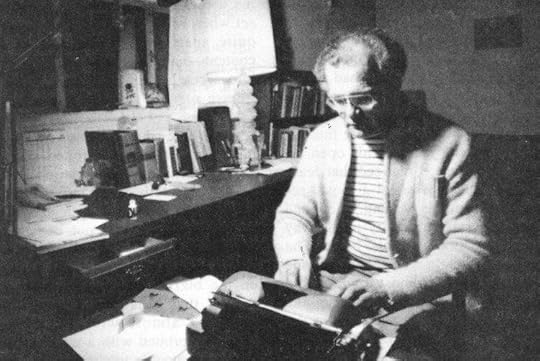
Thinking of Thomas Hanna, pictured here, with gratitude (and some sadness)

Thank you for your pioneering work,Thomas Hanna!
The other reason why Clinical Somatics and other types of self-care aren't more mainstream is that in our society, we've been taught to let doctors and other health professionals make decisions about our health. We grow up thinking that they are the experts in our personal health. Now, Western medicine is truly incredible in some ways, especially in life-threatening situations. But when it comes to chronic health conditions that are caused by lifestyle, visiting a practitioner of Western medicine is fairly useless. We need to make changes in how we're moving, eating, sleeping, dealing with stress, etc. We need to take responsibility for our own health. Most people haven't grown up expecting to have to do this, so it can take a big shift for people to be willing to really take the reins when it comes to their health. And it may take time, patience, and a lot of exploration to find the right solutions for their unique health situation. But, speaking from personal experience, it is so worth it! For any of your readers who aren't familiar with somatic movement, this video and article are a good introduction.
Bevoya: In your years of doing this work, who do you think is most likely to benefit from the Clinical Somatics approach? Is it a coincidence that I am an overthinker with lifelong migraines and neck pain whose back pain really kicked up in the past couple of years? Is this the kind of story you hear frequently?
Sarah Warren: The type of chronic pain that is relieved by Clinical Somatics is musculoskeletal pain caused by chronic muscle tension. The majority of chronic pain cases fall into this category, but certainly not all. Tight muscles themselves are sore and painful. They pull our connective tissues tight, leading to tendinitis and ligament sprains. They pull our skeleton out of alignment, leading to joint degeneration. Misalignment of our skeleton puts pressure on nerves, leading to nerve pain. So, the underlying cause of most musculoskeletal pain is functional—chronically tight muscles—but the end result might be a structural issue, like a herniated disc or cartilage that has worn away.
So, people whose pain falls into that category are those who will benefit from Clinical Somatics. But on top of that, people need to be willing to slow down and take some time each day to lie down and practice the exercises. This is very hard for some people! Some folks really struggle to do the very slow exercises and focus on what they're feeling in their body, because they're used to moving quickly and having an external focus. These tend to be the Type A “go-getters.” I get quite a few emails from these students who report that at the beginning of their learning process they had a really hard time, then as the weeks and months went on, they gradually got comfortable with slowing down and focusing on their internal sensations. And then a whole new world opened up to them. I love getting those emails!
Bevoya: I found and bought your book and online exercises out of desperation after I had tried everything else to improve the iliopsoas tendinopathy I was diagnosed with. So many physical therapist appointments, and my next step was about to be more x rays and a corticosteroid shot to the hip...and none of it was helping. I am three weeks into your program and the improvement is significant. More than that, I am living differently in my body. In particular, I am relaxing my belly muscles more frequently during the day and doing diaphragmatic breathing. What are some of the specific things that other people say they notice about how their body changes after Clinical Somatics?
Sarah Warren: There are so many positive changes that people experience! The most common reason people come to Clinical Somatics is for pain relief, and that's what I focus on in my practice, so that's what I hear about most often from students. Muscle tension relief and improved posture are also inevitable if you practice the exercises regularly. Stress relief, better breathing, better sleep. The ability to return to activities and workouts that they love to do but couldn't because of their pain. A new relationship with their body, with heightened sensation and awareness throughout their body. The ability to quickly and easily get themselves out of pain if a new or old pain arises. Increased empathy, patience, and enjoyment of their daily lives. And, since we hold psychological tension in our bodies as muscle tension, some people report the release of longheld emotional stress and trauma.
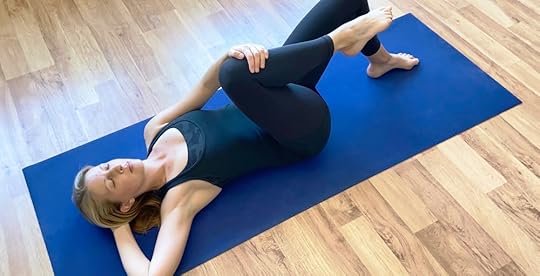
Sarah Warren demonstrating the One-sided Arch & Curl. The key to clinical somatics exercises is to move slowly and stay attuned to the muscle group you’re engaging as you go.
Bevoya: What are some things that Clinical Somatics can't help with? For example, I have Achilles tendinitis in my right ankle. I assume that this will not be improved by Clinical Somatics. Is that true? In response to my newsletter, a friend wrote "It looks like the exercises are centered on helping with back and torso pain, which my probs are more in my feet and knees... I wonder if maybe those would be helped residually, though?"
Sarah Warren: Clinical Somatics works with the entire body, and can definitely relieve Achilles tendinitis and other issues in the extremities of the body. Posture and movement patterns begin in the core of the body—our core is like the foundation of a house. If there is muscle tension or misalignment in the core of our body, it affects our entire body. Often, an issue in the core of the body is actually felt in our extremities, so we think that's where the problem is. For example, let's say you're hiking one hip up higher than the other (functional leg length discrepancy). That's an issue in the core of your body: your waist muscles and lower back muscles are tight, hiking your hip up. But you may only feel pain in one of your knees, because your weight is shifted to that side, putting an unnatural amount of pressure and strain on that knee. No amount of therapy focused on that knee is going to solve the underlying problem, which is the fact that your hips are out of alignment. So in Clinical Somatics, we always start by working with the core of the body so that we can address foundational issues. Then as the learning process continues, we introduce more movements that work with the extremities. Regarding your Achilles tendinitis, you can read my article on tendinitis to learn about the full-body patterns of tension that are typically involved. And in answer to the first part of your question: Yes, there are some types of pain that Clinical Somatics doesn't address. Basically, any type of pain that isn't caused by chronic muscle tension or habitual body use. For example, pain resulting from peripheral neuropathy, which is most often caused by diabetes, infections, or exposure to toxins. Another example is painful autoimmune conditions; the pain in these conditions is caused by inflammation, so the cause of the autoimmune condition needs to be addressed. This often involves a combination of factors like diet, stress, infections, and exposure to toxins. Chronic pain can also be neuroplastic in nature, meaning that the nervous system adapts by making your pain increase over time. Pain receptors become more sensitive, the spinal cord becomes more responsive to pain signals, and more neurons in the brain are recruited to respond to pain signals. I write about that type of pain in this article.

Sarah Warren demonstrates the One-sided Arch & Curl from another angle. One of the things I love about her approach is how detailed it is. Sarah shares the level of information I need to understand and learn!
Bevoya: What is your vision for this work in the future? Do you have a dream about how ClinicalSomatics will be incorporated into medical fields or as treatments suggested by doctors? Are there obstacles to that?
Sarah Warren: Yes, in an ideal world, doctors would refer their patients to Clinical Somatics in the same way they currently refer them to physical therapy. That would be amazing! I believe we'll get there, but there are some obstacles. Clinical Somatics isn't currently covered by health insurance, so that's a big obstacle. Before that can happen, the Somatics community (which includes Clinical Somatic Educators and Hanna Somatic Educators) needs to come together to form an organization that includes certified practitioners from all the major training programs. There must be guidelines put in place to ensure that the training programs are all teaching the same basic information. Once this organization is in place, I believe the next step would be introducing licensure for Clinical Somatics and Hanna Somatics practitioners. Once we have this type of regulation in place for how Clinical/Hanna Somatics is practiced, then we could pursue getting covered by insurance. Going back to my answer to your first question: I believe we'd be much farther along in this process if Thomas Hanna hadn't passed away.
Regarding my personal approach: I don't have much patience for dealing with institutions. At the moment, I feel like trying to introduce Clinical Somatics into mainstream medicine would just slow down my efforts. I really enjoy going straight to the people who need it, and making Clinical Somatics accessible for them. I've always felt like this is my role. When I first learned about Clinical Somatics, I felt like most people do—why doesn't everyone know about this? In addition to the reasons I already listed, another reason is that “what Clinical Somatics is” can be a tough thing to communicate. We use words like “pandiculate” and “sensorimotor awareness” that people have never heard. We talk about the stretch reflex (myotatic reflex) and the gamma feedback loop, and tell people not to do static stretching—the opposite of what they've been told their entire life!
My passion has always been: How can I communicate what Clinical Somatics is in a really clear, simple way so that people understand how they can benefit from it? So, that's what I strive to do every day through my website and my courses. I wish that literally every human being could practice Clinical Somatics. Can you imagine what a wonderful world that would be? There would be a dramatic reduction in chronic pain, and associated problems like depression. There would be a reduction in opioid prescription, abuse, and related deaths. There would be a vast reduction in elective orthopedic surgeries, like hip and knee replacements. Not to mention reduced healthcare costs! And, people could be more physically active as they age, would would extend their lives and improve the quality of their lives. It may sound a bit crazy to say that all of these effects would result from everyone practicing Clinical Somatics, but once you do it for yourself and experience the benefits, you know it's true.
A Q&A about Clinical Somatics with Sarah Warren

Photo by Charlotte Karlsen
Clinical Somatics changed my life and it might yours, too.
When I find something that works, I am not shy about it. That’s why I’ve been shouting from the rooftops about Sarah Warren and her work bringing Thomas Hanna’s clinical somatics to the wider world via through her book and online courses. In this Q&A I get the chance to ask Sarah the questions I’ve had since first starting my clinical somatics practice. Two reasons to be thankful for our digital age: access to new information and the ability to connect with the people who inspire you! Thank you, Sarah, for taking the time to share everything you’ve learned with me and with voyagers everywhere!
Bevoya: Sarah, I am so grateful to you for your work bringing Clinical Somatics to me in an accessible, intuitive, day-by-day format. I have been researching mindbody approaches to healing pain for years and never found an approach to help me reset my nervous system and release muscle tension like yours. Why do you think it is that this kind of healing is so hard to find?
Sarah Warren: I believe the main reason why Clinical Somatics isn't more well-known is that Thomas Hanna, the man who developed the method, died in a car accident at a relatively young age. He had just started teaching his first professional training, so when he passed away there were 38 practitioners who were only partially trained. His widow, Eleanor Criswell, continued to teach, and these 38 practitioners worked with Hanna's long waiting list of clients. Hanna was a passionate, charismatic teacher with a dedicated following. People would travel across the country to have sessions with him and attend his workshops. But when he passed away, the momentum he had created slowed way down. I'm certain that if he had been able to live to old age, Clinical Somatics would be very well-known.

Thinking of Thomas Hanna, pictured here, with gratitude (and some sadness)

Thank you for your pioneering work,Thomas Hanna!
The other reason why Clinical Somatics and other types of self-care aren't more mainstream is that in our society, we've been taught to let doctors and other health professionals make decisions about our health. We grow up thinking that they are the experts in our personal health. Now, Western medicine is truly incredible in some ways, especially in life-threatening situations. But when it comes to chronic health conditions that are caused by lifestyle, visiting a practitioner of Western medicine is fairly useless. We need to make changes in how we're moving, eating, sleeping, dealing with stress, etc. We need to take responsibility for our own health. Most people haven't grown up expecting to have to do this, so it can take a big shift for people to be willing to really take the reins when it comes to their health. And it may take time, patience, and a lot of exploration to find the right solutions for their unique health situation. But, speaking from personal experience, it is so worth it! For any of your readers who aren't familiar with somatic movement, this video and article are a good introduction.
Bevoya: In your years of doing this work, who do you think is most likely to benefit from the Clinical Somatics approach? Is it a coincidence that I am an overthinker with lifelong migraines and neck pain whose back pain really kicked up in the past couple of years? Is this the kind of story you hear frequently?
Sarah Warren: The type of chronic pain that is relieved by Clinical Somatics is musculoskeletal pain caused by chronic muscle tension. The majority of chronic pain cases fall into this category, but certainly not all. Tight muscles themselves are sore and painful. They pull our connective tissues tight, leading to tendinitis and ligament sprains. They pull our skeleton out of alignment, leading to joint degeneration. Misalignment of our skeleton puts pressure on nerves, leading to nerve pain. So, the underlying cause of most musculoskeletal pain is functional—chronically tight muscles—but the end result might be a structural issue, like a herniated disc or cartilage that has worn away.
So, people whose pain falls into that category are those who will benefit from Clinical Somatics. But on top of that, people need to be willing to slow down and take some time each day to lie down and practice the exercises. This is very hard for some people! Some folks really struggle to do the very slow exercises and focus on what they're feeling in their body, because they're used to moving quickly and having an external focus. These tend to be the Type A “go-getters.” I get quite a few emails from these students who report that at the beginning of their learning process they had a really hard time, then as the weeks and months went on, they gradually got comfortable with slowing down and focusing on their internal sensations. And then a whole new world opened up to them. I love getting those emails!
Bevoya: I found and bought your book and online exercises out of desperation after I had tried everything else to improve the iliopsoas tendinopathy I was diagnosed with. So many physical therapist appointments, and my next step was about to be more x rays and a corticosteroid shot to the hip...and none of it was helping. I am three weeks into your program and the improvement is significant. More than that, I am living differently in my body. In particular, I am relaxing my belly muscles more frequently during the day and doing diaphragmatic breathing. What are some of the specific things that other people say they notice about how their body changes after Clinical Somatics?
Sarah Warren: There are so many positive changes that people experience! The most common reason people come to Clinical Somatics is for pain relief, and that's what I focus on in my practice, so that's what I hear about most often from students. Muscle tension relief and improved posture are also inevitable if you practice the exercises regularly. Stress relief, better breathing, better sleep. The ability to return to activities and workouts that they love to do but couldn't because of their pain. A new relationship with their body, with heightened sensation and awareness throughout their body. The ability to quickly and easily get themselves out of pain if a new or old pain arises. Increased empathy, patience, and enjoyment of their daily lives. And, since we hold psychological tension in our bodies as muscle tension, some people report the release of longheld emotional stress and trauma.

Sarah Warren demonstrating the One-sided Arch & Curl. The key to clinical somatics exercises is to move slowly and stay attuned to the muscle group you’re engaging as you go.
Bevoya: What are some things that Clinical Somatics can't help with? For example, I have Achilles tendinitis in my right ankle. I assume that this will not be improved by Clinical Somatics. Is that true? In response to my newsletter, a friend wrote "It looks like the exercises are centered on helping with back and torso pain, which my probs are more in my feet and knees... I wonder if maybe those would be helped residually, though?"
Sarah Warren: Clinical Somatics works with the entire body, and can definitely relieve Achilles tendinitis and other issues in the extremities of the body. Posture and movement patterns begin in the core of the body—our core is like the foundation of a house. If there is muscle tension or misalignment in the core of our body, it affects our entire body. Often, an issue in the core of the body is actually felt in our extremities, so we think that's where the problem is. For example, let's say you're hiking one hip up higher than the other (functional leg length discrepancy). That's an issue in the core of your body: your waist muscles and lower back muscles are tight, hiking your hip up. But you may only feel pain in one of your knees, because your weight is shifted to that side, putting an unnatural amount of pressure and strain on that knee. No amount of therapy focused on that knee is going to solve the underlying problem, which is the fact that your hips are out of alignment. So in Clinical Somatics, we always start by working with the core of the body so that we can address foundational issues. Then as the learning process continues, we introduce more movements that work with the extremities. Regarding your Achilles tendinitis, you can read my article on tendinitis to learn about the full-body patterns of tension that are typically involved. And in answer to the first part of your question: Yes, there are some types of pain that Clinical Somatics doesn't address. Basically, any type of pain that isn't caused by chronic muscle tension or habitual body use. For example, pain resulting from peripheral neuropathy, which is most often caused by diabetes, infections, or exposure to toxins. Another example is painful autoimmune conditions; the pain in these conditions is caused by inflammation, so the cause of the autoimmune condition needs to be addressed. This often involves a combination of factors like diet, stress, infections, and exposure to toxins. Chronic pain can also be neuroplastic in nature, meaning that the nervous system adapts by making your pain increase over time. Pain receptors become more sensitive, the spinal cord becomes more responsive to pain signals, and more neurons in the brain are recruited to respond to pain signals. I write about that type of pain in this article.

Sarah Warren demonstrates the One-sided Arch & Curl from another angle. One of the things I love about her approach is how detailed it is. Sarah shares the level of information I need to understand and learn!
Bevoya: What is your vision for this work in the future? Do you have a dream about how ClinicalSomatics will be incorporated into medical fields or as treatments suggested by doctors? Are there obstacles to that?
Sarah Warren: Yes, in an ideal world, doctors would refer their patients to Clinical Somatics in the same way they currently refer them to physical therapy. That would be amazing! I believe we'll get there, but there are some obstacles. Clinical Somatics isn't currently covered by health insurance, so that's a big obstacle. Before that can happen, the Somatics community (which includes Clinical Somatic Educators and Hanna Somatic Educators) needs to come together to form an organization that includes certified practitioners from all the major training programs. There must be guidelines put in place to ensure that the training programs are all teaching the same basic information. Once this organization is in place, I believe the next step would be introducing licensure for Clinical Somatics and Hanna Somatics practitioners. Once we have this type of regulation in place for how Clinical/Hanna Somatics is practiced, then we could pursue getting covered by insurance. Going back to my answer to your first question: I believe we'd be much farther along in this process if Thomas Hanna hadn't passed away.
Regarding my personal approach: I don't have much patience for dealing with institutions. At the moment, I feel like trying to introduce Clinical Somatics into mainstream medicine would just slow down my efforts. I really enjoy going straight to the people who need it, and making Clinical Somatics accessible for them. I've always felt like this is my role. When I first learned about Clinical Somatics, I felt like most people do—why doesn't everyone know about this? In addition to the reasons I already listed, another reason is that “what Clinical Somatics is” can be a tough thing to communicate. We use words like “pandiculate” and “sensorimotor awareness” that people have never heard. We talk about the stretch reflex (myotatic reflex) and the gamma feedback loop, and tell people not to do static stretching—the opposite of what they've been told their entire life!
My passion has always been: How can I communicate what Clinical Somatics is in a really clear, simple way so that people understand how they can benefit from it? So, that's what I strive to do every day through my website and my courses. I wish that literally every human being could practice Clinical Somatics. Can you imagine what a wonderful world that would be? There would be a dramatic reduction in chronic pain, and associated problems like depression. There would be a reduction in opioid prescription, abuse, and related deaths. There would be a vast reduction in elective orthopedic surgeries, like hip and knee replacements. Not to mention reduced healthcare costs! And, people could be more physically active as they age, would would extend their lives and improve the quality of their lives. It may sound a bit crazy to say that all of these effects would result from everyone practicing Clinical Somatics, but once you do it for yourself and experience the benefits, you know it's true.
February 19, 2024
AI for Mental Health

Happy President’s Day to all US-based voyagers,
How great is it to have a day off for no reason? Fear not, I’m using my day wisely to write you all, wherever you may be, about artificial intelligence1 and mental health.
“But wait!” you may be saying to yourself, “Isn’t AI the bad guy? Don’t we hate AI?”
Some people certainly do, and many more fear what AI could become, but for now, I’m taking Hamlet’s approach: There is nothing either good nor bad, but thinking makes it so. To me, AI is not a prison.
That said, it’s an easy topic to get sick of. I’m not sure exactly where we are in the current hype cycle around AI, but I know we’ve hovering past the peak of inflated expectations:

For those of you who are sick of AI, I don’t blame you for groaning when you saw this post. I’ll waste no more time and dig into a first way2 you can make AI work for you and your mental health3 :
Use AI to transport your mind to a new placeAI makes visualization exercises much, much easier.Visualization is a way to transport your mind to a new place. In theory, it’s easy; you just think up a new environment. The hard part comes when you second-guess yourself or your technique, wondering if you’re doing it “the right way.” This is just the sort of thing an overthinker is likely to do, of course, so be aware and try to cut that self-doubt out of the equation before you begin this technique.4
I spent years trying to make simple visualization work for me. I would sit with my eyes closed and try to envision a beach, or the opening of Sound of Music (where the hills were alive). I got a little relaxation from it, but not much, so I added the extra steps in my book to help myself (and you) get specific and focus on the senses. That helped, but it wasn’t until I added AI into the mix that my visualizations started to get really powerful.

My visualization journey started on Instagram, where talented artists like this one were creating new kinds of scenes using generative AI.
At first, I found myself simply being inspired by the new kinds of experimental art I was seeing. I’d always conjured images in my head when reading, but this level of detail was entirely new to me. I started collecting artists and images and calling it “visualization fodder”:

There is no rhyme or reason to my AI visualization feed. I tune into how the image makes me feel in my body when deciding what to save.
And if it had ended there, it would still have been interesting and useful. But it did not end there. One night I awake in the middle of the night and found myself unable to sleep. I start down my usual visualization path (Sound of Music mountains, smell of cut grass, big open skies, singing while twirling, yadda yadda), but it wasn’t working. Instead of continuing to attempt to conjure my own visualizations, instead I began to think of a favorite AI image I had recently seen:

Here’s a link to the account in case you want to explore it yourself.
It reminded me of a kind of perfectly coiffed Peewee’s Playhouse.5 I started to imagine myself walking up the stairs, looking at the orange bushes and pink trees. I concocted a doorbell sound in my ear, and before the front door could open…I was asleep. There was something about the detail in the original image that spurred my creativity — but in a soothing and relaxing way. This is exactly what visualizations are supposed to do.
Step-by-step guide to AI visualizationStart by tuning into how you feel when you see new AI imagery on Instagram or elsewhere. What do you like? How does it feel? What song might go with the place?
Save images that make you feel something — inspired, relaxed, transported. This may not seem like it, but it is an important step. By intentionally saving those feelings that the images are evoking in you, you are building pathways to the feelings for the future.
Choose one of the images you’ve saved, and explore it more in your mind. This could be as simple as imagining what is behind a closed door, or what the cover if a book on a shelf may look like.
When you are next trying to fall asleep, try revisiting that space. You are following a feeling here, folks. It is not easy to do, but as you remember the image that inspired you, try specifically to follow the parts that feel good and let the rest drop away. This can take some practice, but over time, it does work.
Create a greatest hits of your favorite visualizations. These are the ones that you know work. In a way, this is just an updated, more detailed version of counting sheep. The difference is that you are kick-starting the visualization with the creativity of AI.
Getting into a “feeling” state instead of a “thinking” state can be very hard. It took me decades to learn how to shut off my head, and even now, it’s still spotty work. I will use every tool at my disposal to calm my nervous system and mind so that I can be more present for my husband, daughter, friends, and colleagues. This one is working for me—maybe it will for you, too, fellow voyager? Best of all, it is totally free.
Next up in this series: How an AI-drafted writing practice can kickstart your self-discovery. Until then, keep voyaging.
1 I’ll be using the most accessible terms I can in this post. The umbrella term artificial intelligence covers a range of functionality, some of which is still theoretical. This post will focus on generative AI.
2 This is Part 1 of 3. I didn’t want to overwhelm anyone including myself so I’m putting this in a footnote lol.
3 In particular, I’m focused on how AI can help you regulate your nervous system. I could get into lots of detail about why this is important, but I only have part of today to write this, so here’s a place to start if you’re curious.
4 These lines were taken from my first book, Get Out of My Head.
5 I watched a lot, a lot of Peewee’s Playhouse as a kid.
February 12, 2024
How to Join the Beautiful Voyager Slack Community

Meet real humans. Not friendly bots.
Have you heard of the group chat platform called Slack? If yes, read on for how to join the Beautiful Voyager Slack community. If not, here’s a short video that introduces the concept:
Increasingly, Slack has becoming a way for special interest groups to gather, meet, and “talk” (virtually) about whatever’s on their mind. I first started the BV Slack channel in 2016. I wanted a space to be able to connect with people without having to go through the hassle of using social media apps, and I wanted the connection to be seamless with the rest of my life. And most importantly, I wanted to know if I could get other overthinkers like me to find out that they weren’t alone.
As of Feb 2024, The Beautiful Voyager Slack channel has 720 members.The people in the Slack group come from a variety of backgrounds and places around the world. I don’t even know who everyone is, which is fine as far as I’m concerned. My goal is to create community, which means creating the right space for people to feel comfortable hang out. One of my big ground rules is: It’s always OK to drop away from the group and return whenever you feel like it. If you feel pressure, we’re not guiding the community right!
Joining is very easy. Start by clicking on this link then following instructions!Updated Feb 2024.
How to Join the Slack Channel for Overthinkers

Meet real humans. Not friendly bots.
Have you heard of the group chat platform called Slack? If yes, read on for how to join the Beautiful Voyager Slack community. If not, here’s a short video that introduces the concept:
Increasingly, Slack has becoming a way for special interest groups to gather, meet, and “talk” (virtually) about whatever’s on their mind. I first started the BV Slack channel in 2016. I wanted a space to be able to connect with people without having to go through the hassle of using social media apps, and I wanted the connection to be seamless with the rest of my life. And most importantly, I wanted to know if I could get other overthinkers like me to find out that they weren’t alone.
As of Feb 2024, The Beautiful Voyager Slack channel has 720 members.The people in the Slack group come from a variety of backgrounds and places around the world. I don’t even know who everyone is, which is fine as far as I’m concerned. My goal is to create community, which means creating the right space for people to feel comfortable hang out. One of my big ground rules is: It’s always OK to drop away from the group and return whenever you feel like it. If you feel pressure, we’re not guiding the community right!
Joining is very easy. Start by clicking on this link then following instructions!Updated Feb 2024.
February 1, 2024
20 Books for Stress, Anxiety, and Overthinking

Imagine that the titles below are in my little free library. Photo by me.
A reading list of books to help overthinkers navigate life in an overstimulated worldIn 2016 I created a recommended reading list for anxiety newbies in order to share the books that first helped me on my journey to understanding how stress, anxiety, and overthinking were affecting my life. I’ve been revisiting that list and updating it with some of the books year over year. My goal is to answer the question: Which books help people make sense of the feelings overtaking their nervous system? Which books help with physical and emotional pain? Let this list act as a place to start.
For understanding how anxiety works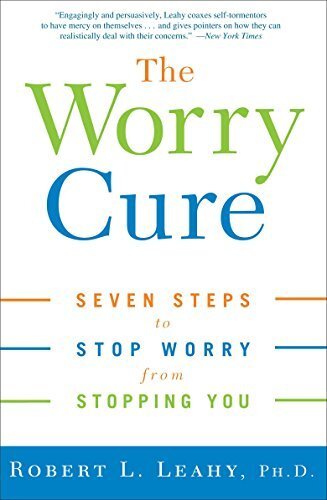 The Worry Cure
The Worry Cure I'm not a huge fan of the title, since I think the word worry is a big turn-off and confusing for a lot of overthinkers. But overlook that, cause this really is the book to start with. It lays a great foundation, especially for people who are just starting to get their head around the whole "I have anxiety" thing.
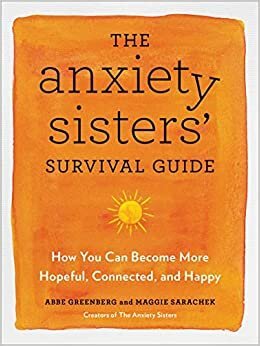 2. The Anxiety Sisters’ Survival Guide
2. The Anxiety Sisters’ Survival GuideCould there have been a more natural and intuitive connection than mine with the Anxiety Sisters? I don't think so. Abbe Greenberg and Maggie Sarachek have built an online community of 200K people and host a popular podcast called The Spin Cycle. In their work, they blend their personal experience with their professional training as counselors, mental health advocates, researchers, and educators. Their book is terrific. The down-to-earth, actionable advice that Abbe and Maggie share is dead on. Great work, sisters!
 3. Unwinding Anxiety
3. Unwinding AnxietyIn this book, Dr Brewer explores the ways in which we all create habits around our anxiety — and how to break them down and rebuild them in healthy ways.The book is great. The app is useful (though a big clunky and costs a pretty penny). You can get the gist from the book, though, at a lower cost.
[image error] 4. Anxiety: The Missing Stage of GriefClaire Bidwell Smith’s Anxiety: The Missing Stage of Grief was the first book that revealed to me that anxiety lives in the body autonomous from the mind, and can cause panic attacks hours or even a day after the feelings flood the system, causing a lack of connection between cause and effect. It expanded my sense of what anxiety is, and how the physical response appears in unexpected places…like while grieving.
For dealing with the muscle tension and physical pain that anxiety brings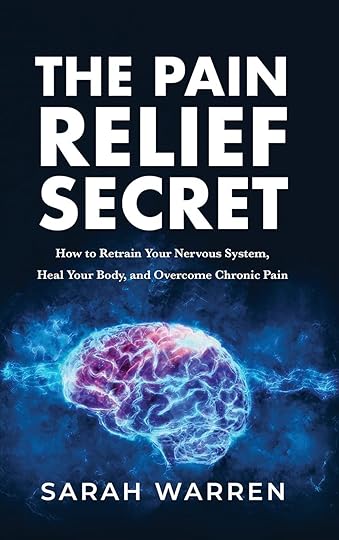 5.
The Pain Relief Secret
5.
The Pain Relief Secret
Sarah Warren’s book The Pain Relief Secret: How to Retrain Your Nervous System, Heal Your Body, and Overcome Chronic Pain has been a gamechanger for me. I bought this book in May 2023 and found it a bit hard to engage with at first, so I stopped reading it. It wasn't until I was so desperate to improve my hip and lower back pain that I tried it experimentally by signing up for Level One Clinical Somatics exercises online. Once I started doing the exercises, I became obsessed with the entire program and devoured the book.
The core concept is called "pandiculation" which at first glance seems like stretching but involves teaching your muscles to release tension. Sarah goes in-depth about why stretching can lead to tighter muscles and that alone is pretty interesting (if you find that kinda thing interesting). It takes about half an hour a day to start and now I do about an hour every morning.
Sarah’s very clear step-by-step guidance provides not just the how but the why and a brain like mine needs that. Understanding more about how muscles actually work has really changed how I live in my body. To read more about how this book and Clinical Somatics is changing my life, check out this newsletter that I wrote about it.
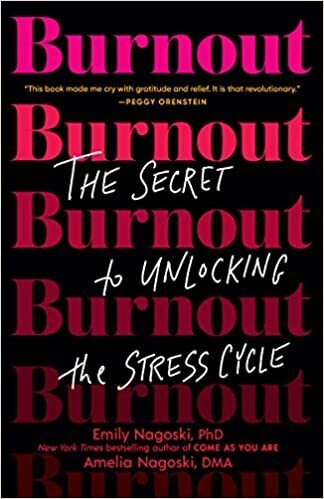 6. Burnout
6. BurnoutI heard about this book on a podcast and it was a happy surprise to learn that we share a literary agent! Burnout delves into how emotions can affect our bodies without us even knowing it’s happening. The book explores some of the core reasons women may be facing the kinds of symptoms I talk about so frequently, and then it works to systematically break the stress cycle down. I listened to the audiobook and found I got something out of every single chapter.
[image error] 7. Women’s Guide to Managing MigraineI’m including Susan Hutchinson’s Women’s Guide to Managing Migraine just in case it helps just one of you reading this post. As a lifelong migraine sufferer, I have never found a book on migraines that helped me understand how the hormone flood affects my migraine cycles. It’s also hormone waves that affect our bodies when we’re stressed. The key words to spot in this subtitle is “Understanding the Hormone Connection” — that is crucially important in both migraine and anxiety.
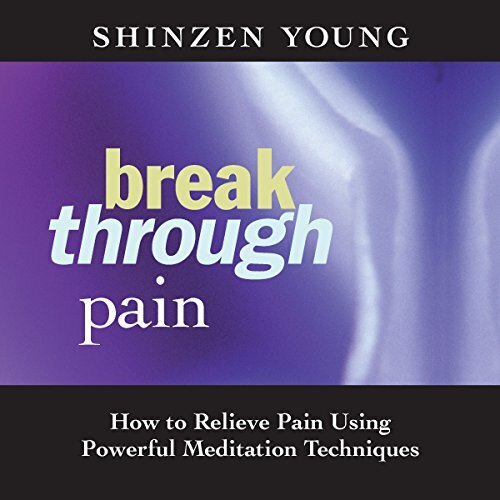 8. Break Through Pain
8. Break Through PainA good friend of mine named Molly had a painful medical issue a few years ago. “The pain was bad as labor,” she said. “And the only thing that helped me was Shinzen Young’s Break Through Pain.” I was so struck by the clarity of the experience she described and know that the next time I am facing physical discomfort I will be using the audio version of these meditations to help me. I think you should, too.
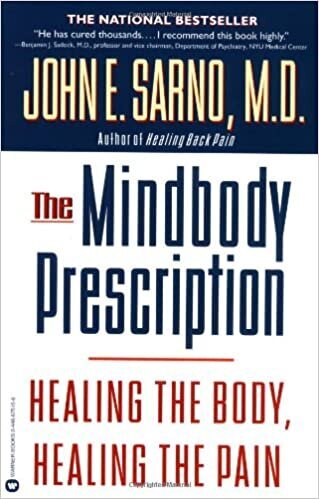 9. The Mindbody Prescription
9. The Mindbody Prescription I was handed Dr John Sarno’s Mindbody Prescription in my fated neurologist appointment where I first learned I has Generalized Anxiety Disorder (age 40). It was the first time I truly understand that the mind-body connection wasn’t theoretical, but real—and that I was experiencing it. Sarno digs into the personality traits of people who are susceptible to this kind of physical response to emotional pain. I wonder if you might recognize yourself in what he describes?
For understanding emotions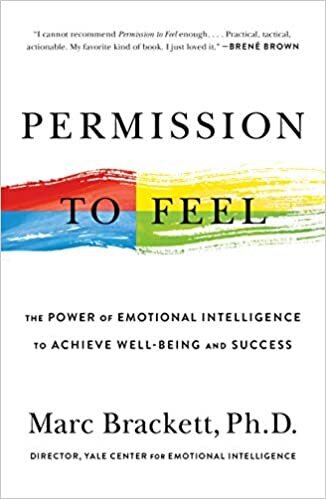 10. Permission to Feel
10. Permission to Feel 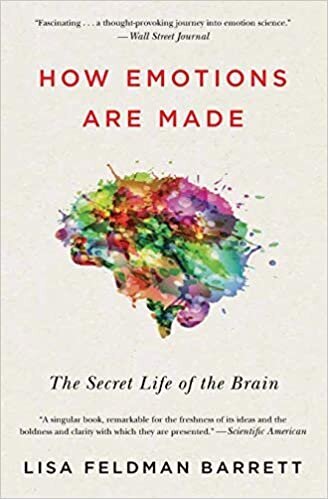 11. How Emotions are Made
11. How Emotions are Made When it comes to books on understanding what emotions really are, you can’t do better than these two. I’m biased when it comes to Marc Brackett’s Permission to Feel, as I am lucky enough to get to work with him on How We Feel. And Lisa Feldman Barrett’s How Emotions are Made changed the way I think about how emotions are processed. This is core, fundamental groundwork that will has helped me frame emotions in my life in a new way.
 12. Unbroken: The Trauma Response Is Never Wrong
12. Unbroken: The Trauma Response Is Never WrongI have become a devotee of new-old kind of therapy called narrative healing. Around since the 1970s, it seems to be breaking through in a more popular way, now. It’s particularly effective with overthinkers like myself who are prone to editing our stories to suit our audiences. A great starting point MaryCatherine McDonald, Unbroken: The Trauma Response Is Never Wrong. The book radically altered my understanding of the role of storytelling in my own healing. McDonald’s breakthrough insight: finding a “dwelling place” for traumatic experiences is critical to the functioning of our nervous system. In other words, two people may have identical difficult experiences as children, but only the one who lacks a trusted friend, parent, or teacher to help them “find a home” for their story will experience it as trauma.
For a mindful approach [image error] 13. Catching the Big FishI’m a sucker for David Lynch: his movies, his approach to meditation, and his creative process. I dip into this simple book regularly to reset. Tapping into creativity helps me deal with overthinking, stress, and anxiety. I recommend you try it.
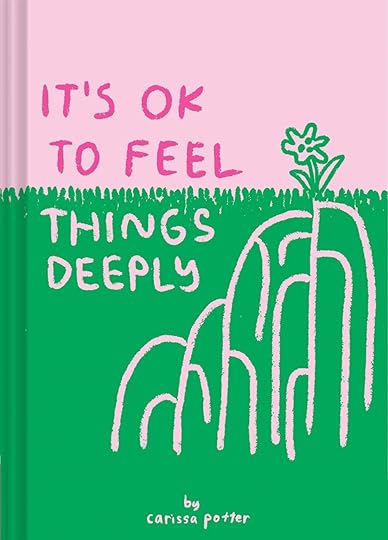 14. It’s OK to feel things deeply
14. It’s OK to feel things deeplyCarissa Potter’s lovely little book is a visual reminder that being sensitive is nothing to be ashamed of. I don’t think we can be told It’s OK to feel things deeply enough. Let this book try to do it for you as it has for me.
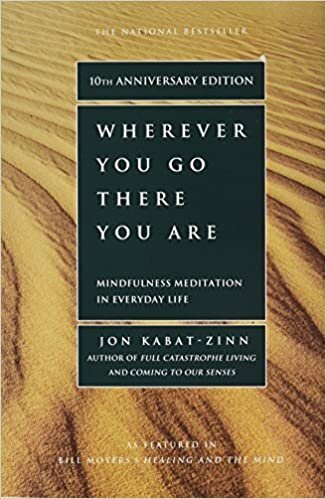 15. Wherever You Go, There You Are
15. Wherever You Go, There You AreThe title alone: Wherever You Go, There You Are. I can’t tell you how many times, when considering a life change or move, I think of those words. This book is filled with principles about mindfulness, but I love the metaphors best. A great way to get out of your head.
For gaining bigger perspective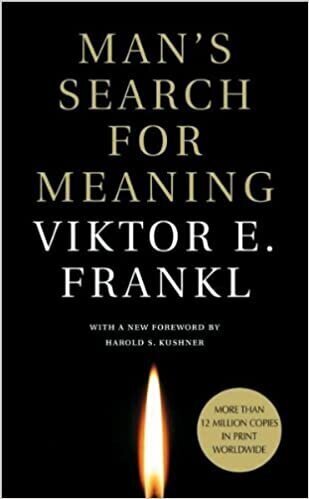 16. Man’s Search for Meaning
16. Man’s Search for Meaning Victor Frankl’s Man’s Search for Meaning brings me a sense of inner peace and human connection in a way very few do. If you feel you are at the end of your rope and unsure how to face daily life, this book is here for you.
[image error] 17. Culture of FearMy husband brought the Culture of Fear into our marriage. He has always been a staunch believer in using data to make sense of the things we fear. “If we really understood how statistics worked, we wouldn’t be afraid of airplanes at all and we’d take driving more seriously,” he says.
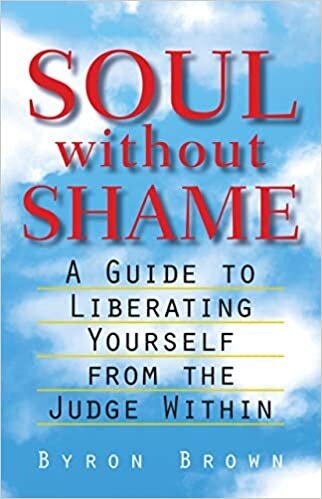 18. Soul without Shame
18. Soul without Shame A colleague of mine at Pinterest recommended Soul without Shame, saying “I know it sounds cheesy, but I think this book is actually really good.” And she was right. Simply acknowledging the role of our soul in our life brought me peace. It might you, too. Give it a try.
For understanding the brain [image error] 19. My Stroke of InsightI read Jill Bolte Taylor’s My Stroke of Insight many, many years ago and have never forgotten it. In this book, a brain scientist describes the stroke that affected her brain, thinking, and emotions. I still think “step to the right”—a phrase Taylor repeats frequently, describing the feelings of wellbeing that come from turning down the brain chatter of our left brains.
[image error] 20. Atomic Habits“But this book isn’t about anxiety at all,” you might be saying to yourself. But I’d argue that James Clear’s book Atomic Habits is a great book for people who are feeling anxiety in their bodies. It helped me understand how to spot and support healthy habit-building in myself, which in turn positively affects mental health. Think of it as a pillar of cognitive behavioral therapy: The more you can tune into the actions that make up your day, the easier it will be to start changing your feelings for the better.
 Bonus book!
Bonus book!Please forgive me for putting my own book, Get Out Of My Head, on this list. But it is probably the book that has helped me deal with stress, anxiety, and overthinking the most. Putting my own experience into words has helped me make sense of it. I hope it helps you too.
Updated Feb 1, 2024



